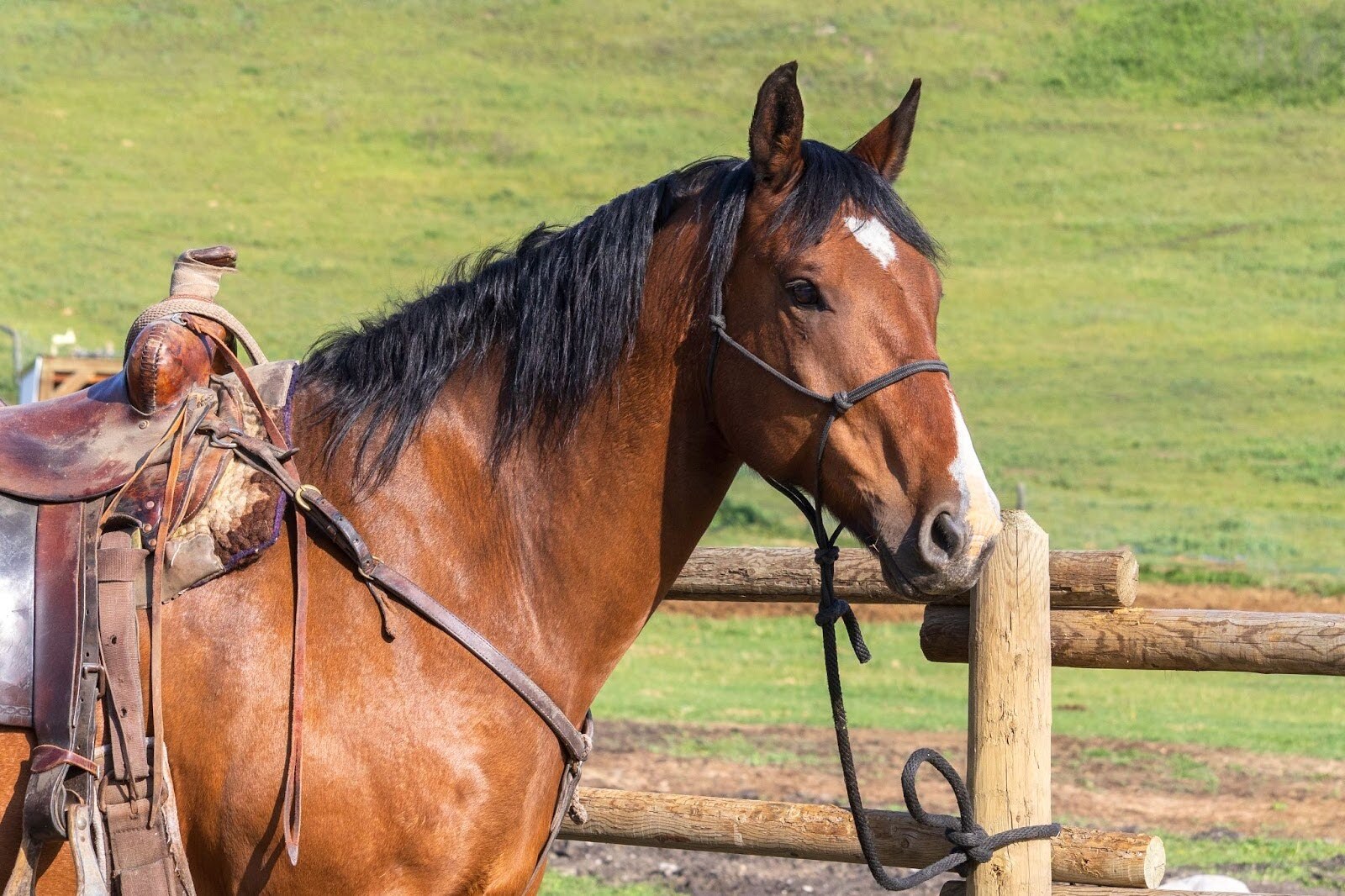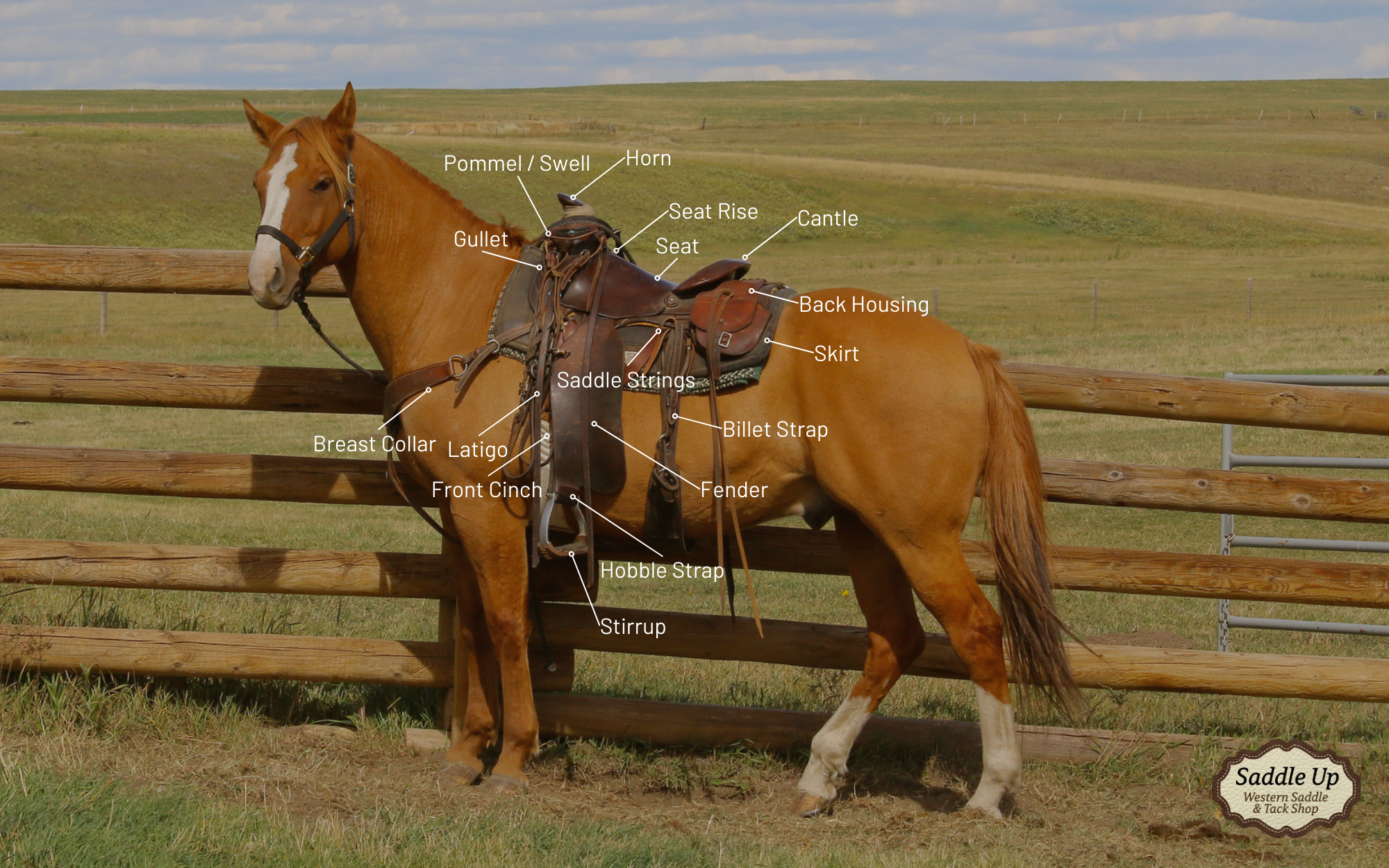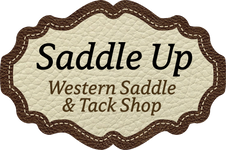The Different Types of Western Saddles and their Purpose
Posted by Lynnsy Johnson - Saddle Up on Aug 26th 2025

Whether you’re chasing seconds in barrel racing, working cattle all day, or spending long hours on the trail, understanding how each saddle design supports you and your horse makes it easier to choose one that’s comfortable, durable, and built for your style of riding.
Parts of a Western Saddle
Before comparing the types of western saddles, it helps to understand the main parts. Each component influences how the saddle fits your horse, supports your rider position, and performs in different disciplines.

- Saddle Horn: Positioned at the front, used for gripping or wrapping a rope. Shape varies: a tall horn or thin horn for quick events, or a reinforced version for a roping saddle.
- Pommel / Swell: The raised front section that forms the base of the horn, adding stability and helping the rider stay centered.
- Seat Rise: Slight incline behind the pommel that positions the rider toward the back for better balance.
- Seat: The main sitting area. Depth depends on the discipline; a deep seat pairs well with a high cantle for security, while a flatter seat with a low cantle offers more freedom.
- Cantle: The back edge of the seat that supports the rider’s position. Higher cantle designs offer more back support, while lower cantle styles allow easier movement.
- Skirt: Leather panels under the seat that give your saddle its style or a particular look. Often tooled or decorated for style.
- Back Housing: Reinforces the rear of the saddle.
- Gullet: The open space above the horse’s back that clears the withers and spine; width affects saddle fit.
- Front Cinch: Keeps the saddle anchored in place, referred to as a girth on an English saddle.
- Latigo: Long strap used to secure the front cinch through the D-ring; allows for tightening your cinch and making fine adjustment.
- Latigo Strap Holder: Holds excess latigo neatly out of the way.
- Rear or Flank Cinch: Adds stability and prevents the saddle from lifting at the rear.
- Rear or Flank Billet Strap: Attaches the back cinch to the saddle securely.
- Cinch Hobble: Connects the front and back cinch under the belly to keep the back cinch from sliding too far back and becoming a bucking strap.
- Fenders: Wide leather panels that connect the stirrups to the saddle and protect the rider’s legs.
- Stirrups: Support the rider’s feet; slim stirrups are favored in barrel racing for quick repositioning, whereas Roper stirrups have a wider tread for balance in posting to rope.
- Hobble Strap: Keeps stirrups in alignment at the base of the fenders.
- Saddle Strings: Leather ties for attaching gear, essential for long hours in a trail saddle.
- Breast Collar: Helps hold the saddle forward on steep climbs or when pulling weight.
- Unique Features: Decorative silver, tooling, or a different shape skirt can add function and style.
10 Common Western Saddles
1. All-Around Saddle
An all-around saddle is built for versatility, making it a favorite for riders who do a little of everything. It’s sturdy enough for light roping, balanced enough for speed events, and comfortable for long hours in the saddle. Whether you’re working cattle, competing in the arena, or enjoying trail riding, this is a reliable, multi-purpose option.
- Use: Ideal for riders who switch between different riding styles like ranch work, pleasure riding, and local competitions.
- Features: Medium weight, reinforced horn for light roping, balanced cantle height, and a seat that offers both security and freedom of movement.
- What to Consider: Make sure the saddle fit works for both you and your horse’s back. A durable tree and solid rigging will handle varied activities without sacrificing comfort.
2. Barrel Saddle
A barrel racing saddle is built for speed, agility, and keeping the rider secure during sharp turns. Its lighter weight helps the horse accelerate faster, while the deep seat and higher cantle keep you locked in as you round the barrels.
- Use: Designed for barrel racing and other speed-based events where quick turns and fast acceleration are essential.
- Features: Lightweight design, compact skirt, slim stirrups for quick foot movement, tall horn for grip, and close contact feel for precise leg cues.
- What to Consider: A quality barrel saddle should fit snugly to prevent slipping at high speeds. It’s not intended for roping, as the horn isn’t built for that level of strain.
3. Cutting Saddle
A cutting saddle allows the rider to stay balanced while giving the horse full freedom to move quickly and change direction. With a flatter seat and low cantle, it keeps you out of the way while working cattle.
- Use: Built for cutting competitions, team penning, and sorting.
- Features: Low cantle, tall horn, high pommel, and long skirts. The seat is flat with a slight rise near the pommel for balance and close contact with the horse.
- What to Consider: Since a cutting saddle is not meant for roping, focus on comfort, balance, and saddle fit for precise cattle work.
4. Mounted Shooting Saddle
A mounted shooting saddle is designed for speed and maneuverability, with features that make it easier for the rider to switch firearms during competition. Lightweight and streamlined, it offers a deep seat for stability while still allowing quick dismounts.
- Use: Best for cowboy mounted shooting events where agility and firearm handling are priorities.
- Features: Smaller horn, forward-tilted swells, free-swinging fenders, and a close contact skirt for responsive leg cues.
- What to Consider: Not intended for roping. Prioritize balance and clearance so your gear and movement aren’t obstructed during competition.
5. Ranch Cutting Saddle
A ranch cutting saddle blends the agility of a cutting saddle with the durability of a ranch saddle. It’s designed for cattle work but tough enough to handle roping and ranch work.
- Use: Suitable for both cutting competitions and day-to-day cattle handling.
- Features: Sturdy tree, back cinch, thicker horn for roping, long skirts, and a flat seat with a slight rise near the pommel.
- What to Consider: This is a heavier saddle, so check the weight against your needs. Make sure the saddle fit is correct for long days on the job.
6. Ranch Saddle
A ranch saddle is built for heavy-duty, everyday use. Designed for long hours in the saddle, it’s a workhorse for everything from dragging logs to roping cattle.
- Use: Best for all-day ranch work and handling livestock.
- Features: Stout horn for roping, strong tree, saddle strings for carrying gear, back cinch, and often has a high cantle for security.
- What to Consider: Ranch saddles are heavy, so make sure you’re comfortable with the weight. Work with an experienced saddle maker to ensure durability and saddle fit for your horse’s back.
7. Reining Saddle
A reining saddle is designed for precision. It gives the rider the ability to deliver subtle cues while staying balanced through spins, slides, and stops.
- Use: Specifically for reining competitions and training.
- Features: Lower horn, moderate cantle height, flatter seat for hip movement, and close contact skirts to enhance communication with the horse.
- What to Consider: Since a reining saddle isn’t meant for roping, focus on fit, balance, and a seat that allows freedom of leg movement for performance maneuvers.
8. Roping Saddle
A roping saddle is built for strength, stability, and safety. Its reinforced horn and heavy-duty tree can handle the strain of roping and dallying without compromising the saddle.
- Use: Designed for team roping, calf roping, and ranch work involving cattle.
- Features: Thick horn, strong tree, flank cinch, lower cantle for easier dismounts, and heavy rigging for durability.
- What to Consider: These saddles are heavier than most, so consider your horse’s stamina and your own handling needs. Correct saddle fit is crucial for comfort during repeated roping runs.
9. Show Saddle
A show saddle combines function with presentation. It’s built to position the rider in perfect equitation form while showcasing ornate craftsmanship that stands out in the arena.
- Use: Best for western pleasure classes, showmanship, and competitions where appearance is judged.
- Features: Decorative silver, intricate tooling, long skirts, and a seat designed for balance. Usually has a different shape skirt and unique features to catch the eye.
- What to Consider: Show saddles are heavier and can be more expensive due to the added details. Choose one that fits well and allows you to maintain proper posture without sacrificing saddle fit.
10. Trail / Pleasure Saddle
A trail saddle is made for comfort and practicality during long hours of trail riding. It’s lighterweight, cushioned, and designed to minimize fatigue for both rider and horse.
- Use: Ideal for relaxed rides, trekking, and multi-hour trips.
- Features: Trail saddles often have a padded or gel seat for all-day comfort, yet some riders prefer a hard seat; they can have a higher cantle for support, or a lower cantle for a more relaxed feel, short skirts, and saddle strings for carrying essentials.
- What to Consider: Look for lightweight materials, a horn style that suits your needs, and a saddle fit that won’t cause sore spots on your horse’s back over distance.
Choosing the Perfect Saddle
Your saddle choice depends on your riding discipline, saddle fit, and the comfort needs of both rider and horse.
- Match the cantle style (low cantle, higher cantle, or high cantle) to your support preference.
- Select the horn style (tall horn, thin horn, or lower horn) for your activity.
- Factor in weight, durability, and whether you’ll use back or flank cinch for added support and stability.
- Choose trusted brands like Circle Y or McCall for a dependable build, but always start with fit for the horse.
Ride with Confidence
Understanding the types of western saddles and how each one supports both you and your horse makes it easier to find the perfect saddle for your riding style. Each saddle’s design has its own strengths, features, and considerations. The right choice comes down to matching the saddle’s purpose with your needs, ensuring proper saddle fit, and selecting quality craftsmanship that will last for years.
At Saddle Up Colorado, we know that finding the right saddle is about performance, durability, and a great fit. Our team can help you explore different options, answer your questions, and guide you toward the saddle that’s built for your kind of riding. Whether you’re chasing seconds in barrel racing, tackling all-day ranch work, or enjoying long hours on the trail, we’re here to make sure you ride with confidence.
FAQs
What’s the difference between a western saddle and an English saddle?
A western saddle offers more seat surface, a horn, and features for stability during western riding, while an English saddle is lighter with a closer leg position for jumping or dressage.
Which type of western saddle is best for beginners?
An all-around saddle or trail saddle works well, offering stability, comfort, and versatility.
What makes a barrel racing saddle different from a trail saddle?
A barrel racing saddle is lighter, has a higher cantle and deep seat for sharp turns, and slim stirrups for quick movement, while a trail saddle prioritizes comfort for long hours.
Can one saddle work for multiple disciplines?
Yes, an all-around saddle is designed for different riding styles, but each specialized saddle has advantages in its intended use.
Originally Published On: January 16, 2020
Updated On: August 26, 2025
